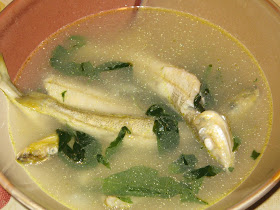When I started scouring wet markets in Makati in the early years of my marriage, I noticed how woefully small basasong were in Metro Manila. And not only that, they were priced dearly, too, for such size.
I never bought, understandably, until the family transferred to Cavite, and I learned that the fish I mistook for my childhood friend and foe was an altogether different species. I cannot be blamed, for asuhos was and still is an unknown fish in Pangasinan, but where basasong (called kalaso in Tagalog) abounds that it is commonly made into daing.
They have striking similarities, though. Porously flaky ivory
flesh, silvery white outer color, long narrow bodies. Even the rich tastes are
close. But whereas the basasong can grow as large as overgrown bangus, the
largest asuhos I’ve seen have difficulty reaching six inches, and these are
altogether rare.
Asuhos (whiting, Sillaginidae) appear in plenty in Cavite City when the
rains come. They arrive in pails at the wet market, and are sold by the tumpok –
heaped on small tin plates, priced anywhere from P30 to P80, depending on the
size of the fish and the container. I’ve
never been offered it by the kilo, but I buy like three plates for a time, or
two for the big ones, and they are good for two meals already.
My kids love asuhos fried, even though it is fussy to get to the thin flesh (we always cook fish whole). It is fortunate that asuhos are not spiny, having only the central skeleton and spines along the fins. The really small ones are better deep-fried to a crunch, so we can just bite into them whole, spines and all.
I think asuhos are a Katagalugan fish, since during office lunches
a colleague from Bulacan said she grew up eating them. They never fried them,
though, but poached them into a dish called sinuwam, which is like tinola, or
pinatisan. The asuhos are boiled and seasoned with either salt or patis (fish
sauce) and topped with sili leaves.
So I cook sinuwam with asuhos, too. The resulting broth is rich
from fish fat, tasting almost like tinolang manok but without the cholesterol
and with the added benefit of omega-3. Since the sinuwam I know (from other
colleagues from other areas in Tagalog country) contain corn kernels my sinuwam
is sometimes thick with corn, preferably the white variety. And because I am a
Pangasinense, I add a slice of peeled ginger, as all broth, all dishes
actually, must be cooked with it.
I know it is not only Tagalogs who are chummy with asuhos, for fillets of it are what are made into kisu tempura in Japanese restaurants. And when I was in Japan battered asuhos fillets were offered for breakfast along with shredded cabbage every single day of my month-long stay. Friends who went to the Middle East found asuhos in grocery stores, so they bought them and fried them for a taste of home.
Asuhos disappear from the Cavite wet market towards the cold
months and on to summer. The supply is not
as abundant now as when we were just new in the area, but they still come,
thankfully, and the prices are pretty much stable. So we enjoy them while we
can, fully maximizing the advantage of having access to fresh fish straight
from the fishermen. Asuhos fillets, as well as whole fish, are now available in supermarkets in Metro
Manila, but they sell for a premium, and in what state is
anybody’s guess.
Related Posts
Rainy Season
Fare in Pangasinan I’m Missing






asuhos looks like bonur fish in pangasinan
ReplyDeleteYes they're a bit like bonor, but very much like basasong, in taste and texture.
ReplyDeleteWhat is asuhos in America what kind of fish? Is it smelt ?
ReplyDeleteWhat’s asuhos in English?
ReplyDeleteWhat’s asuhos in English?
ReplyDelete